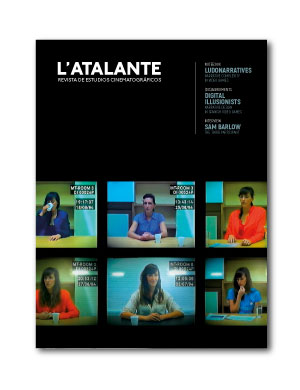“It’s impossible for me to be that woman again”: Embodiment and Identity in 'Quién te cantará'
Published 2021-01-31
Keywords
- Haptic Visuality,
- Affect,
- Embodiment,
- Gesture,
- Celebrity Culture
- Feminine Subjectivity. ...More
How to Cite
Copyright (c) 2021 L'Atalante. Journal of film studies

This work is licensed under a Creative Commons Attribution-NonCommercial-NoDerivatives 4.0 International License.
Abstract
This paper analyses Carlos Vermut’s Quién te cantará [Who Will Sing to You] (2018) with a focus on the relationship between film form and female subjectivity. The study examines the construction of the film as a perceptual experience, where corporeality and gestures take centre stage to convey the anxieties of women whose identity is impacted by celebrity culture. Taking haptic film theory as a framework, the film is examined as an overcoming of the hegemony of optical visuality, with an analysis of how the film’s mise-en-scène, sound, and focus on the body operate in a sensorial narrative.
Downloads
References
Barker, J. M. (2009). <em>The Tactile Eye. </em><em>Touch and the Cinematic Experience</em>. Los Angeles: University of California Press.<br>
Bas, B. (2018, 25 de septiembre). Carlos Vermut, la voz cantante del (otro) cine español. <em>El País. </em>Recuperado de https://elpais.com/elpais/2018/09/18/eps/1537288327_157714.html.<br>
Beugnet, M. (2008). Cinema and Sensation: Contemporary French Film and Cinematic Corporeality. <em>Paragraph, 31</em>(2), 173-188. <br>
Chare, N., Watkins, L. (2015). Introduction: gesture in film. <em>Journal for Cultural Research</em>,<em> 19</em>(1), 1-5. <br>
Debord, G. (1995). <em>La sociedad del espectáculo</em>. Santiago de Chile: Naufragio.<br>
Del Río, E. (2008). <em>Deleuze and the Cinemas of Performance. Powers of Affection</em>. Edimburgo: Edinburgh University Press.<br>
Deleuze, G. (1987). <em>La imagen-tiempo. Estudios sobre cine 2</em>. Barcelona: Paidós.<br>
Dyer, R. (1998). <em>Stars</em>. Londres: British Film Institute.<br>
Dyer, R. (2004). <em>Heavenly Bodies. Film Stars and Society</em>. Londres, Nueva York: Routledge.<br>
Ferencz-Flatz, C., Hanich, J. (eds.) (2016). Film and Phenomenology. <em>Studia Phaenomenologica</em>, XVI. Recuperado de https://zetabooks.com/all-titles/studia-phaenomenologica-volume-16-2016-film-and-phenomenology.<br>
Gorfinkel, E. (2012). Weariness, Waiting: Enduration and Art Cinema’s Tired Bodies. <em>Discourse, 34</em>(2-3), 311-347.<br>
Holmes, S., Redmond, S. (eds.) (2006). <em>Framing Celebrity. New Directions in Celebrity Culture</em>. Londres, Nueva York: Routledge.<br>
Marks, L. U. (2000). <em>The Skin of the Film. Intercultural Cinema, Embodiment, and the Senses</em>. Durham, Londres: Duke University Press.<br>
Mulvey, L. (1999). Visual Pleasure and Narrative Cinema<em>.</em> En L. Braudy y M. Cohen (eds.),<em> Film Theory and Criticism: Introductory Readings</em> (pp. 833-844). Nueva York: Oxford University Press.<br>
Paszkiewicz, K. (2020). Touch as Proximate Distance: Post-Phenomenological Ethics in the Cinema of Isabel Coixet. <em>Film-Philosophy</em>,<em> 24</em>(1), 22-45.<br>
Pérez Guevara, J. A. (2018). <em>Entrevista a Carlos Vermut.</em> Recuperado de https://www.youtube.com/watch?v=Rf3FmQaS1jo.<br>
Sobchack, V. (1992). <em>The Address of the Eye. A Phenomenology of Film Experience</em>. Princeton: Princeton University Press.<br>
Tobin Stanley, M. (2018). The Interplay of Female Voice (lessness) and Agency in the Face of Objectification, Commodification, and Fetishization in Carlos Vermut’s <em>Magical Girl</em> (2014). En J. Brady y M. L. Jeffers (eds.), <em>Shifting Subjectivities in Contemporary Fiction and Film from Spain</em> (pp. 88-112). Cambridge: Cambridge Scholars Publishing.<br>
Vidal, B. (2019). A Somatic Poetics of Crisis Cinema: The Gesture of Self-Harm in Three Spanish films. <em>Hispanic Research Journal, 20</em>(1), 42-57.</p>

